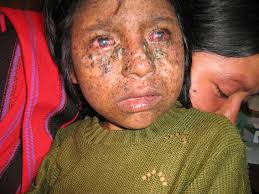 Xeroderma pigmentosum (XP) is a genetic disorder in which there is a decreased ability to repair DNA damage such as that caused by ultraviolet (UV) light.
Xeroderma pigmentosum (XP) is a genetic disorder in which there is a decreased ability to repair DNA damage such as that caused by ultraviolet (UV) light.
Damage to DNA which occurs in skin cells from exposure to UV light is normally repaired by nucleotide excision repair (NER): with xeroderma pigmentosum, this damage is not repaired.
The XPA protein acts during NER as a scaffold for assembly of other DNA repair proteins at sites of DNA damage to ensure appropriate excision of the damage.
As abnormalities in DNA progress, cells malfunction and eventually become malignant or die.
XP is autosomal recessive, with mutations in at least nine specific genes able to result in the condition.
One of the most frequent defects in xeroderma pigmentosum is an autosomal recessive genetic defect in which nucleotide excision repair (NER) enzymes are mutated, leading to a reduction in or elimination of NER.
Those affected with the autosomal recessive disorder XP are extremely sensitive to UV light produced by the sun and develop pigmented spots, tumors, and skin cancer with minimal exposure.
Individuals with XP are about 1,000 times more likely to develop skin cancer than individuals without the disorder.
The molecular defects in XP cells result in a greatly elevated induction of mutations in sun-exposed skin of affected individuals,
accounting for the pigmentation changes and the skin cancers.
Tumors from XP patients reveal p53 mutations characteristic of UV exposure in the majority of tumors
Symptoms include: a severe sunburn after only a few minutes in the sun, freckling in sun exposed areas, dry skin and changes in skin pigmentation.
Nervous system impairments, such as hearing loss, poor coordination, loss of intellectual function and seizures, may also occur.
Associated with a high risk of skin cancer: about half having skin cancer by age 10 without preventive efforts.
Higher risk of cataracts.
There may be a higher risk of other cancers such as brain cancers.
Usual onset about 6 months of age.
Frequency
1 in 100,000 globally
1 in 370 India
1 in 22,000 Japan
1 in 250,000 USA
1 in 430,000 Europe
1 in 1,000,000 UK
It occurs equally commonly in males and females.
Differential diagnosis
Trichothiodystrophy, Cockayne syndrome, cerebrooculofacioskeletal syndrome, erythropoietic protoporphyria.
Prevention
Completely avoiding sun or UV rays, retinoid creams, vitamin D.
Life expectancy is shortened by about 30 years.
Diagnosis based on symptoms and confirmed by genetic testing.
Treatment:
There is no cure for XP.
Treatment involves completely avoiding the sun using protective clothing, sunscreen and dark sunglasses when out in the sun.
Retinoid creams may decrease the risk of skin cancer.
Vitamin D supplementation is generally required.
Life expectancy is about 30 years less than normal: The most common fate for individuals with XP is early death from cancer.
It causes severe sunburn when exposed to only small amounts of sunlight.
It often occurs during a child’s first exposure to sunlight.
It is associated with the development of many freckles at an early age, solar keratoses, and skin cancers.
Patient’s eyes with XP are painfully sensitive to the sun and may easily become irritated, bloodshot and clouded.
The XPB (ERCC3) protein unwinds the DNA double helix after DNA damage, and mutations in the XPB(ERCC3) gene can lead to XP or XP combined with Cockayne syndrome.
The XPC protein forms a complex with RAD23B protein to form the initial damage recognition factor in global genomic nucleotide excision repair.
TREATMENT:
There is no cure for the disorder.
All treatments are symptomatic or preventive.
Symptoms can be avoided or controlled by completely avoiding exposure to sunlight: staying indoors, wearing protective clothing and using sunscreen when outdoors.
Keratosis can be treated with cryotherapy or topical fluorouracil.
The average life expectancy of an individual with any type of XP and no neurological symptoms is approximately 37 years.
In the presence neurological symptoms, survival is about 29 years.
The probability to survive until 40 years of age may be as high as 70% sufferers have never been exposed to sunlight in their life.
